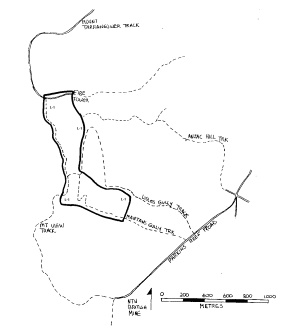LISLES AND MANTONS GULLIES QUARTZ GOLD MINES
MOUNT TARRENGOWER ROAD MALDON, MOUNT ALEXANDER SHIRE
-
Add to tour
You must log in to do that.
-
Share
-
Shortlist place
You must log in to do that.
- Download report




Statement of Significance
The story of quartz mining in Lisles and Mantons gullies revolves around the working of three parallel reefs: Lisles, Mantons, and Braithwaites (or the Mount), all worked extensively by small mining companies during the nineteenth century. The vicinity experienced one period of large-scale mining: in the early 1880s, the Grand Junction Company drove a tunnel from the head of Manton's Gully and, after encouraging results, erected a 24-head battery and three roasting kilns to burn the quartz prior to crushing. The initial success of the Grand Junction during the early 1880s blossomed into a full-scale mining boom, and soon the whole of the ground along the line of the reefs-a distance of a mile and a quarter-was taken up. After the 1880s, however, little work was done.
The Lisles and Mantons Gullies Quartz Gold Mines are of historical, archaeological and scientific importance to the State of Victoria.
The Lisles and Mantons Gullies Quartz Gold Mines are historically and scientifically important as a characteristic example of an important form of gold mining. Gold mining sites are of crucial importance for the pivotal role they have played since 1851 in the development of Victoria. As well as being a significant producer of Victoria's nineteenth century wealth, quartz mining, with its intensive reliance on machinery, played an important role in the development of Victorian manufacturing industry. The Lisles and Mantons Gullies Quartz Gold Mines are important as manifestations of this aspect of gold mining.
The Lisles and Mantons Gullies Quartz Gold Mines are scientifically important as one of the few places known in Victoria where accesible and significant evidence of horse-powered haulage whims still exist. Mining relics in Lisle's and Manton's gullies document a range of mining operations carried out over an 80-year period, from 1856 to the 1930s. The various elements making up the place appear to reflect the extensive use of the tribute system of mining, whereby small co-operative parties of miners laboured under contract to mining companies, for a share of any profits. This system of working is reflected in the dense distribution of the whim platforms (and associated mullock heaps and blacksmith shops) and the continuous line of closely spaced shafts, each group serviced by a carefully constructed siding access track. The occurrence of a mining boom is evinced by relics including the adit and the remains of the 24-head battery and roasting kilns.
The Lisles and Mantons Gullies Quartz Gold Mines are scientifically significant for their potential to yield artefacts and evidence which will be able to provide significant information about the technological history of gold mining.
-
-
LISLES AND MANTONS GULLIES QUARTZ GOLD MINES - Permit Exemptions
General Exemptions:General exemptions apply to all places and objects included in the Victorian Heritage Register (VHR). General exemptions have been designed to allow everyday activities, maintenance and changes to your property, which don’t harm its cultural heritage significance, to proceed without the need to obtain approvals under the Heritage Act 2017.Places of worship: In some circumstances, you can alter a place of worship to accommodate religious practices without a permit, but you must notify the Executive Director of Heritage Victoria before you start the works or activities at least 20 business days before the works or activities are to commence.Subdivision/consolidation: Permit exemptions exist for some subdivisions and consolidations. If the subdivision or consolidation is in accordance with a planning permit granted under Part 4 of the Planning and Environment Act 1987 and the application for the planning permit was referred to the Executive Director of Heritage Victoria as a determining referral authority, a permit is not required.Specific exemptions may also apply to your registered place or object. If applicable, these are listed below. Specific exemptions are tailored to the conservation and management needs of an individual registered place or object and set out works and activities that are exempt from the requirements of a permit. Specific exemptions prevail if they conflict with general exemptions. Find out more about heritage permit exemptions here.Specific Exemptions:EXEMPTIONS FROM PERMITS:
(Classes of works or activities which may be undertaken without a permit under
Part 4 of the Heritage Act 1995)
No permits are required for the following classes of works provided they are
carried out in accordance with the provisions of the Conservation Plan For
Historic Mining Sites prepared by David Bannear in 1996.
Mineral Exploration
Fire suppression duties
Timber production
Weed and vermin control
Public safety
Rehabilitation
-
-
-
-
-
MOUNT TARRENGOWER LOOK-OUT TOWER
 Victorian Heritage Register H1407
Victorian Heritage Register H1407 -
MT TARRENGOWER 1
 Victorian Heritage Inventory
Victorian Heritage Inventory -
COBBERS GULLY 2
 Victorian Heritage Inventory
Victorian Heritage Inventory
-
'ELAINE'
 Boroondara City
Boroondara City -
-oonah
 Yarra City
Yarra City -
..eld House
 Yarra City
Yarra City
-
-










